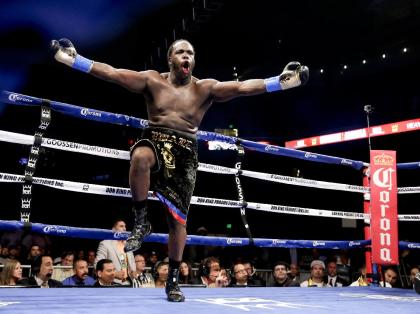Boxing's heavyweight division hopes to have a star on the rise in 2015
LAS VEGAS – There were two men who had a claim to being the world heavyweight champion inside the Grant Sawyer State Office Building on Tuesday.
One, WBC champion Bermane Stiverne, appeared before the Nevada Athletic Commission in order to be licensed for his title defense Saturday at the MGM Grand Garden against power-punching Deontay Wilder.
The other, interim WBA champion Luis Ortiz, attended to answer anti-doping allegations. After a first-round stoppage of Lateef Kayode in September, the anabolic steroid nandrolone was found in Ortiz's system.
Ortiz pleaded for leniency. His attorney argued he ate horse meat, which was contaminated and was the result of the nandrolone. But when quizzed extensively about his diet, Ortiz admitted to eating chicken, beef, pork, brown rice and vegetables, but no horse meat. He was, predictably, fined and suspended.
The point, though, is the fighters' presence in the building was barely detected. Workers going to and from their offices barely gave either man a second look.
There weren't hounds of autograph seekers gathering near the elevators, and the media didn't chase the men into the hall seeking a few comments.
This is 2015, after all, and this is boxing's heavyweight division.
Now, for a second, imagine it was 1971 and it was Muhammad Ali applying for a license and Joe Frazier attending the disciplinary hearing. Or imagine it was 1991 and the two were Mike Tyson and Evander Holyfield. Or that it was 2002 and it was Lennox Lewis and Vitali Klitschko.
At this stage, though, the heavyweight division has fallen so far from the American sporting public's consciousness as to almost not exist.
What's clear is that Wladimir Klitschko is the heavyweight champion and an all-time great. He's not nearly as respected as he should be, largely because of three bad losses earlier in his career.
But since reclaiming the title from Samuel Peter in 2005, Klitschko has made 18 consecutive successful title defenses, winning 14 of them by stoppage.
He's an elite heavyweight who would have been among the best in any era in which he's fought. But because he badly gassed in fights with Ross Puritty and Lamon Brewster, was knocked out by Corrie Sanders and was in trouble in a winning effort over DaVarryl Williamson, he's not regarded highly by many fans.
That's unfair. He's big, athletic, powerful and has a tremendous jab. This isn't to say he would have beaten every heavyweight who ever lived, but this version of Klitschko would have been a handful for all of them and would have more than his share of wins.
Beyond them, though, it's all but impossible to accurately assess the remainder of the crop.
Stiverne and Wilder seem the best of the rest, so to speak. Wilder is a 2008 Olympic bronze medalist who is 32-0 with 32 knockouts, including 18 of them in the first round.

He certainly looks the part, with broad shoulders, a narrow waist and muscles all over. Wilder, though, has fought a shockingly low level of competition, even by the heavyweight division's low standards.
Stiverne is a stout man who has shown he can take – and give – a hard shot. He has never shown the sign that he'd go down at the first big shot landed.
So the question about Wilder is one that has dogged many knockout artist prospects in many divisions over the years: What happens if he hits someone on the chin and they don't go down but throw back a big one? Also, what happens if he's the one being hit on the chin?
Wilder has been so dominant in his career that he's barely taken any punches. So if he goes to fire a big shot at Stiverne and Stiverne responds by catching him on the chin, what happens?
If Wilder takes it, grins, and keeps fighting, that's a great sign. And he just may do that. He just has no history at it and it's hard to put much faith in him with so little evidence.
But Wilder, who didn't even take up boxing until he was 20, has a lot going for him in addition to his 6-foot-7 frame and seemingly big power. He's athletic and moves around the ring much better than most men his size.
He seems to have extremely quick feet, which often play a big role in a fighter's success. And he appears in magnificent physical condition. He hasn't had to go very long – he hasn't had to fight into the fifth round ever – but he seems as if he has the kind of conditioning to endure a long, hard battle.
Stiverne moved to Las Vegas in 2004 and turned pro in 2005. He received much hype in his early days, as his power and boxing ability impressed insiders.
But he, too, opened with a long string of weak opposition, and then was stopped in 2007 by Demetrice King.
He fell off the radar, but he slowly fought his way back. He was impressive in back-to-back wins over Arreola. Arreola is no Joe Louis, but he's a credible, hard-punching heavyweight and Stiverne cleanly handled him both times.
The division seems to be getting better. Unbeaten Bryant Jennings isn't experienced, but he'll most likely get a shot at Klitschko later this year. British heavyweight Tyson Fury hasn't always been the prettiest, but he keeps winning and is showing signs he could be a legitimate contender.
There are other up-and-coming fighters who seem to have some talent, including Anthony Joshua and Joseph Parker. They're a long ways away, though, and they have much to prove.
But it seems that while we weren't looking, the heavyweight division was slowly but steadily improving.
Stiverne and Wilder will get the new year's first opportunity on Saturday to show us just how much better things have gotten.

 Yahoo Sports
Yahoo Sports 